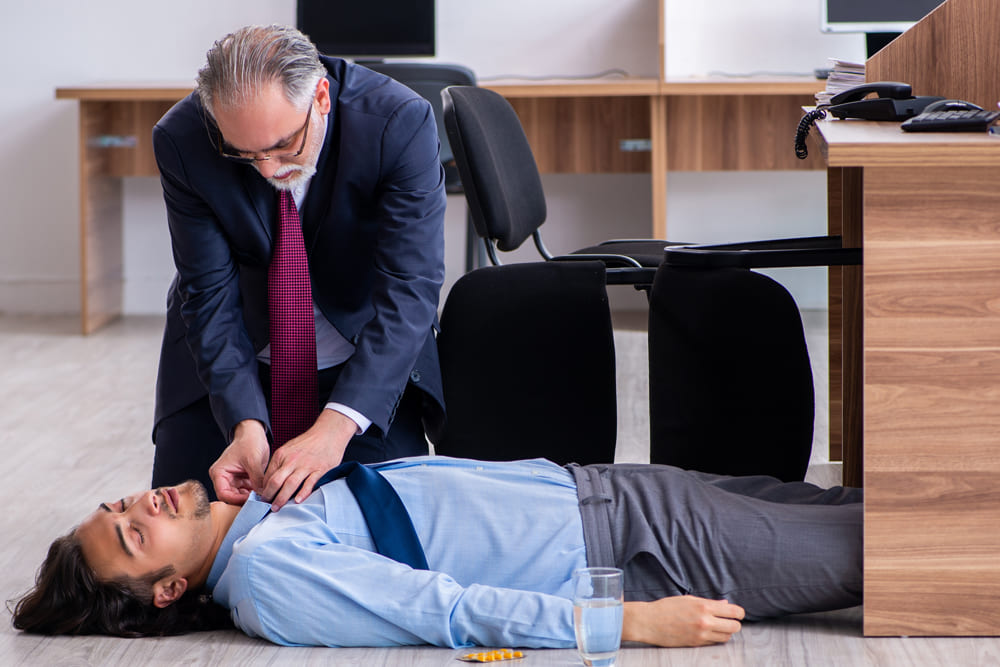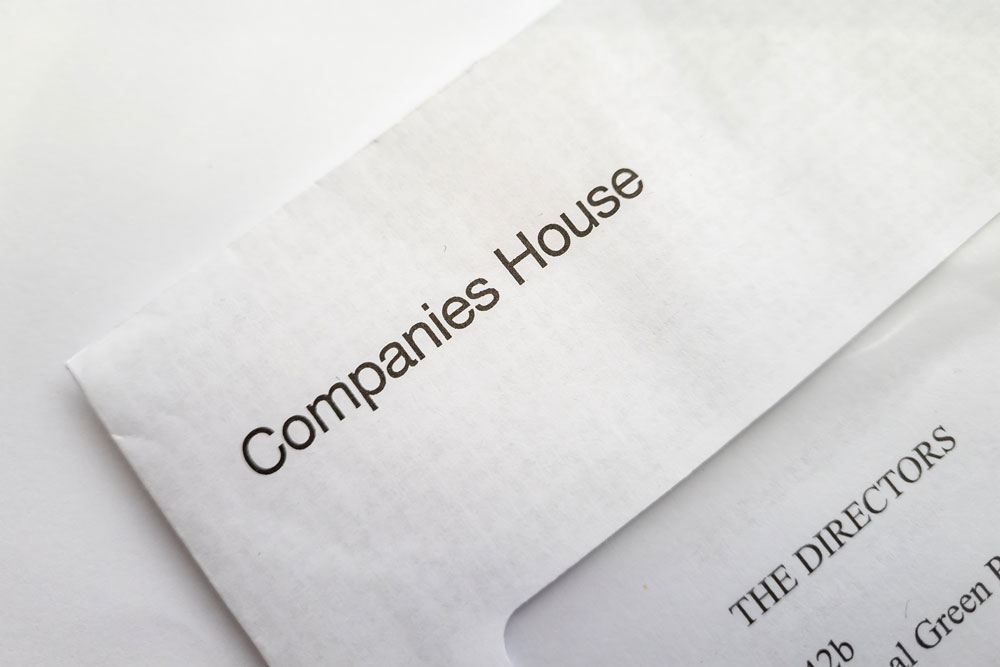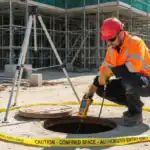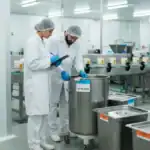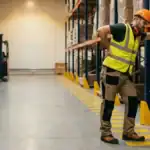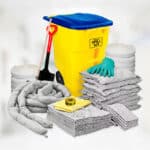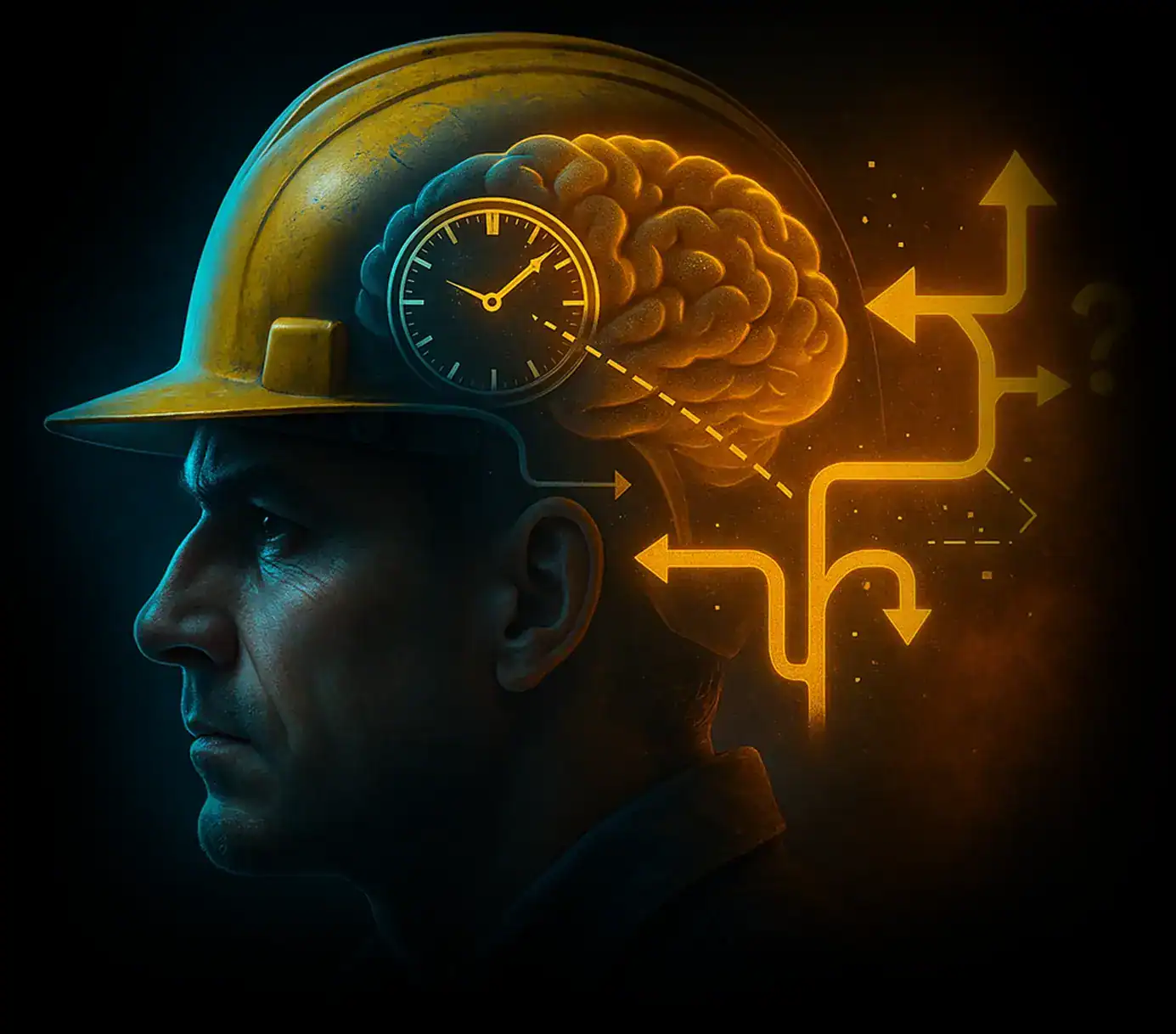
Slips, trips and falls are some of the most common workplace accidents. Although most result in a bruised ego before a broken bone, a surprising number cause serious injuries and significant disruptions. So, for employers and managers, understanding the causes of slips, trips and falls is essential for making their workplaces safe.
In this blog, we explore ten of the most common causes of slips, trips and falls at work and how to fix them. By being proactive, you can drastically reduce the risk of these incidents and prevent one of the leading causes of workplace accidents.
Legal Duties for Controlling Slip, Trip and Fall Hazards
Employers have a legal obligation to ensure a safe working environment under the Health and Safety at Work Act 1974.
To fulfil your overarching duty, you must regularly assess your workplace to spot any hazards that could lead to harm. Once identified, these hazards must be eliminated or controlled through practical measures. This includes addressing common causes of slips, trips and falls.
If you fail to identify and minimise slip, trip and fall risks in your workplace, you may be found non-compliant with health and safety legislation. As a result, the Health and Safety Executive (HSE) may take action against you.
The Seriousness of Slips, Trips and Falls
Statistics from the Health and Safety Executive show slips, trips and falls on the same level as the leading cause of workplace injuries. These incidents caused 32% of non-fatal injuries reported to the HSE in 2022/23. That’s more than the second and third leading cause of injuries combined.
The HSE has this data because it must be notified of certain injuries under the Reporting of Injuries, Diseases and Dangerous Occurrences Regulations (RIDDOR). For these injuries to qualify as reportable, they must have either been severe (such as a fracture or loss of consciousness) or resulted in an absence of seven days or more.
These are not the only slips and trips employers should be worried about. The Labour Force Survey put slip, trip and fall injuries at 96,000 for the same period, making them the second most common injury type. These injuries were self-reported, meaning they weren’t as severe as those reported under RIDDOR, but workers were still hurt.
Beyond the human impact, slips, trips and falls also carry substantial financial costs. The HSE estimates that workplace injuries related to these incidents cost UK businesses over £500 million annually. These costs include both visible expenses, such as insurance premiums and injury-related damages, and hidden expenses, such as production delays, investigation time and fines for non-compliance.
Slips Trips and Falls Training
Our comprehensive Slips, Trips and Falls Training course helps prevent slip, trip and fall incidents by equipping trainees with the knowledge to effectively recognise and reduce associated risks across different work settings. Trainees also learn about their role in maintaining a safe workplace free from slips, trips and falls.
Slip Hazards
A slip occurs when there is not enough traction or friction between the footwear and the walking surface, causing a person to lose balance. Here are some of the most frequent slip hazards:
1. Contamination
Contamination is the official term for a spill and is one of the most common causes of slips in the workplace. It can arise from various sources, including spilt liquids, cleaning solutions, grease, oil and even food debris.
Solutions:
- Cleaning Protocols: Employees should be trained to clean up spills immediately and have quick access to the necessary equipment. Ensure cleaning staff use the right cleaning agents for different types of spills.
- Non-Slip Mats: Place non-slip mats in areas that are frequently wet, such as near entrances, sinks and bathrooms. These mats can provide extra traction and reduce the risk of slipping.
- Drip Trays and Absorbent Materials: Use drip trays under machinery or areas prone to leaks and place absorbent materials in areas where liquid spills are common.
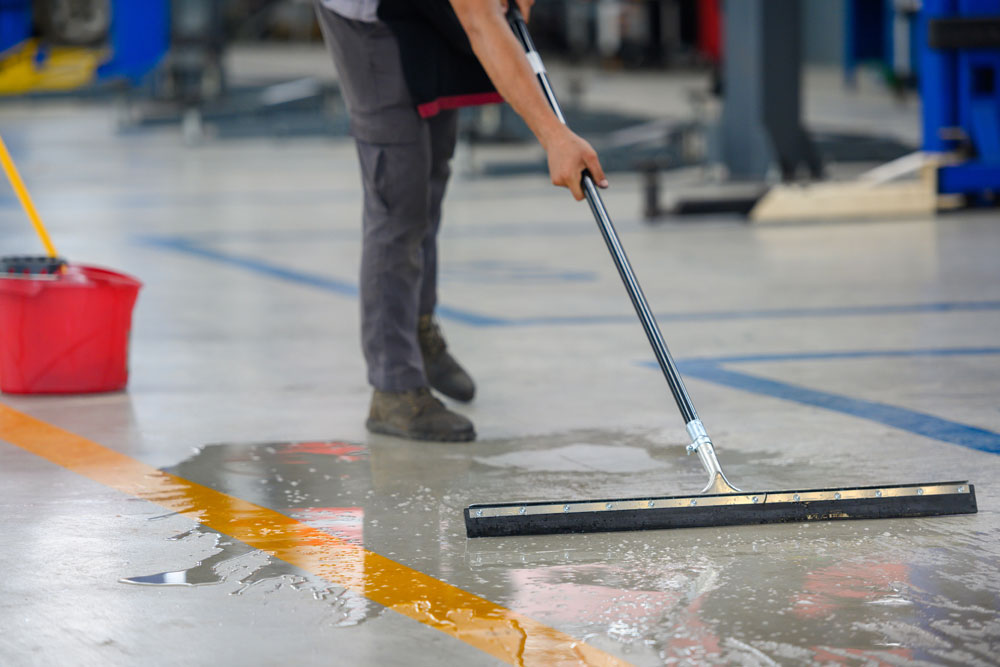
2. Loose Floors
Loose or unstable flooring that can shift underfoot is a significant slip hazard. Rugs, mats and unfixed carpets and tiles all need to be secured. Temporary floor protection can also be a hazard.
Solutions:
- Secure Flooring: Ensure all flooring materials are properly installed and secured. Loose tiles and mats should be fixed immediately. Temporary floor protection should be taken up as soon as possible.
- Regular Inspections: Conduct regular inspections of the flooring to identify and address any areas that have become loose or unstable.
- Appropriate Materials: Use flooring materials that provide good traction and are suitable for the specific conditions of the workplace.
3. Weather Conditions
Weather conditions such as rain, ice and snow can create hazardous conditions both outside and inside the workplace. Water and ice tracked indoors can lead to slippery floors.
Solutions:
- Mats and Umbrella Stands: Place mats at entrances to absorb water and provide umbrella stands to prevent water from being tracked inside.
- Well-Maintained Walkways: Ensure that outdoor walkways are well-maintained and salted during icy conditions.
- Encourage Reporting: Encourage employees to report any hazardous conditions immediately and follow up quickly.
Trip Hazards
A trip occurs when a person’s foot strikes an object, putting them off balance and causing a fall. Here are some of the most frequent trip hazards:
4. Uneven Surfaces
Uneven surfaces, such as loose tiles, worn carpeting or changes in floor level, can easily cause trips.
Solutions:
- Regular Inspections: Conduct regular inspections of the flooring to identify and repair any uneven areas.
- Immediate Repairs: Address any uneven surfaces immediately to prevent trips. This can include fixing loose tiles or replacing worn carpeting.
- Warning Signs: Use clear signs to warn employees of any temporary uneven surfaces undergoing repair or permanent features that can’t be changed. Transition strips are helpful for highlighting where floor levels change.
5. Cluttered Walkways
Clutter is a common cause of trips in the workplace. Items left in walkways, such as boxes, equipment or personal belongings, can create obstacles.
Solutions:
- Housekeeping: Encourage employees to tidy tripping hazards immediately, even if they aren’t responsible for them.
- Adequate Storage: Provide adequate storage solutions for tools and materials to keep them off the floor and out of walkways.
- Work Arrangements: Employees may allow clutter to build up when they can’t deal with it straight away. Work with staff to determine more efficient ways of disposing of rubbish.
6. Hidden or Rounded Steps
Hidden or rounded steps can be a significant trip hazard, especially if they’re not clearly marked or if employees aren’t aware of their presence.
Solutions:
- Proper Markings: Mark hidden steps with bright, contrasting colours to make them easily visible. Use clear signs to alert employees to the presence of hidden or rounded steps.
- Adequate Lighting: Install adequate lighting around steps to ensure they are clearly visible at all times.
7. Loose Cables and Wires
Loose cables and wires can easily cause trips in the workplace, especially in areas with a lot of electronic equipment.
Solutions:
- Cable Management: Use cable management solutions to secure loose wires and keep them out of walkways.
- Routing Away from Walkways: Ensure cables are routed away from walkways and work areas where people frequently walk.
- Regular Inspections: Regularly inspect and maintain cable management systems to ensure they remain effective.
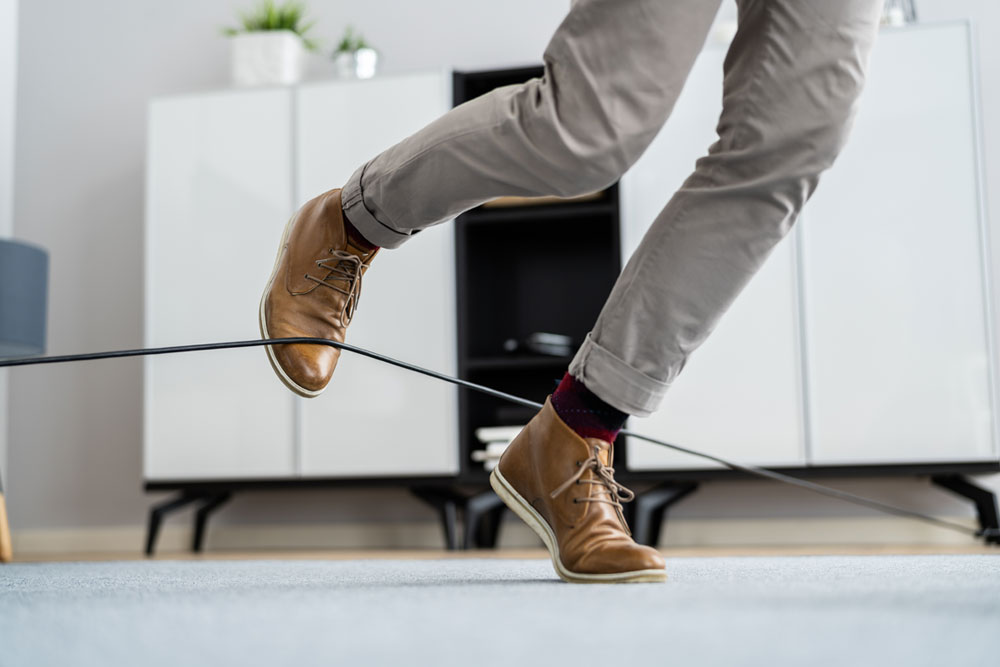
8. Poor Lighting
Poor lighting makes it difficult to see hazards and navigate safely.
Solutions:
- Sufficient Lighting: Install adequate lighting in all areas, including stairwells and corridors.
- Regular Maintenance: Regularly check and replace faulty light bulbs to maintain consistent lighting.
- Motion-Sensor Lights: Use motion-sensor lights in low-traffic areas to ensure they’re well-lit when occupied.
9. Slip and Trip Hazards Created by Cleaning
Cleaning is essential for maintaining a safe workplace, but it can also create slip and trip hazards if not managed properly. Here are some common hazards created by cleaning activities:
- Workers Accessing Areas Being Cleaned: Wet floors during cleaning are a slipping hazard. Solutions include temporarily restricting access to these areas and clearly signposting cleaning activities. If possible, schedule floors to be cleaned out-of-hours when most employees aren’t on the premises.
- Signs Left Out Too Long: Wet floor and cleaning in progress signs are crucial for warning employees of slippery conditions, but they can become trip hazards if left out longer than necessary. To prevent this, train staff to remove signs as soon as the floor is dry and safe to walk on.
- Cables for Cleaning Equipment: Cables for cleaning equipment, such as vacuum cleaners and floor polishers, can create tripping hazards if they’re not properly managed. Keep cables organised and out of walkways, limit the time that cleaning equipment is in use in high-traffic areas and use signs to warn employees. Battery-powered devices are also a safer alternative for some tasks.
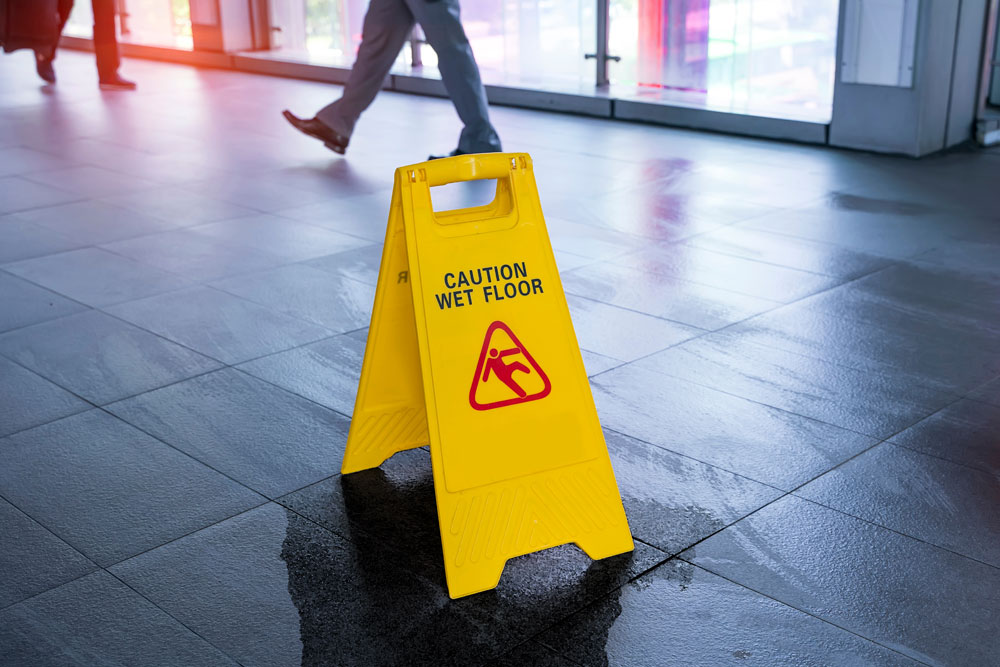
10. Poor Housekeeping
Poor housekeeping is the underlying cause of many slip, trip and fall hazards. Ensuring good housekeeping practices can significantly reduce the risk of these accidents.
Key Issues:
- Spills and Debris: Spilled liquids, food or dropped rubbish can cause slips and trips if not promptly cleaned up.
- Cluttered Walkways: Items left in walkways, such as boxes, tools and personal belongings, create obstacles that can lead to trips.
- Improper Storage: Tools and equipment not stored correctly can protrude into walkways or work areas, creating hazards.
- Unorganised Workspaces: Disorganised workspaces with materials scattered around increase the likelihood of accidents.
Solutions:
- Clear Protocols: Establish clear housekeeping protocols that outline the responsibilities of all employees in maintaining a clean and safe workplace. This includes regular cleaning schedules and immediate clean-up of spills and debris.
- Employee Accountability: Reinforce the importance of good housekeeping practices by holding employees accountable. Encourage everyone to participate in maintaining a clean and hazard-free workspace.
- Training: Train employees to identify and address slip and trip hazards. It’s important everyone shares a ‘see it, sort it’ approach. Anything they can’t handle themselves should be reported to a supervisor as soon as possible.
Slips, Trips and Falls Training
Training is absolutely essential for preventing slips, trips and falls in the workplace. Properly trained employees understand the hazards and know how to tackle them, making the work environment safer for everyone.
Our Slips, Trips and Falls Training gives your team the knowledge and skills they need to prevent these common accidents. This training gets everyone on board with spotting and addressing the causes of slips, trips and falls. With this knowledge, your team will be better at handling hazards and ensuring risks are dealt with promptly and properly.

